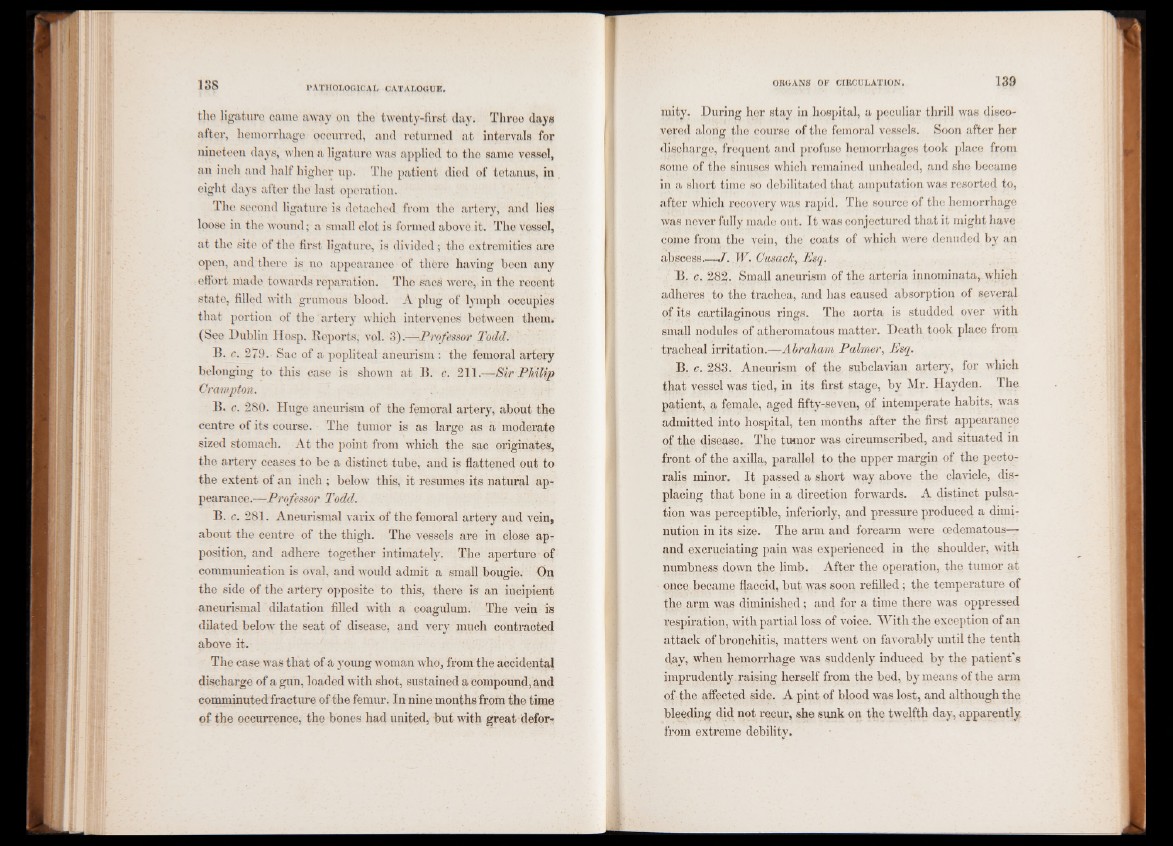
tho ligature came away on the twenty-first day. Three days
after, hemorrhage occurred, and returned at intervals for
nineteen days, when a ligature was applied to tho same vessel,
an inch and half higher up. The patient died of tetanus, in
eight days after the last operation.
The second ligature is detached from tho artery, and lies
loose in the wound; a small clot is formed above it. The vessel,
at the site of the first ligature, is divided; the extremities are
open, and there is no appearance of there having been any
effort made towards reparation. The sacs were, in the recent
state, filled with grumous blood. A plug of lymph occupies
that portion of the artery which intervenes between thenn
(See Dublin Hosp. Reports, vol. 3).—Professor Todd.
B. c. 279. Sac of a popliteal aneurism : the femoral artery
belonging to this case is shown at B. c. 2 1 1 .—Sir Philip
Crampton. .
B. c. 2S0. Huge aneurism of the femoral artery, about the
centre of its course. The tumor is as large as a moderate
sized stomach. At the point from which the sac originates,
the artery ceases to be a distinct tube, and is flattened out to
the extent of an inch ; below this, it resumes its natural appearance.—
Professor Todd.
B. c. 281. Aneurismal varix of the femoral artery and vein,
about the centre of the thigh. The vessels are in close apposition,
and adhere together intimately. The aperture of
communication is oval, and would admit a small bougie. On
the side of the artery opposite to this, there is an incipient
aneurismal dilatation filled with a coagulum. The vein is
dilated below the seat of disease, and very much contracted
above it.
The case was that of a young woman who, from the accidental
discharge of a gun, loaded with shot, sustained a compound, and
comminuted fracture of the femur. In nine months from the tirne
of the occurrence, the bones had united, but with great deformity.
During her stay in hospital, a peculiar thrill was discovered
along the course of the femoral vessels. Soon after her
discharge, frequent and profuse hemorrhages took place from
some of the sinuses which remained unhealed, and she became
in a short time so debilitated that amputation was resorted to,
after which recovery was rapid. The source of the hemorrhage
was never fully made out. It was conjectured that it might have
come from tho vein, the coats of which were denuded by an
abscess J .W • CusacJc, Esq.
B. c. 282. Small aneurism of the arteria innominata, which
adheres to the trachea, and has caused absorption of several
of Its cartilaginous rings. The aorta is studded over with
small nodules of atheromatous matter. Death took place from
tracheal irritation.—-A braham Palmer, Esq.
B. c. 283. Aneurism of the subclavian artery, for which
that vessel was tied, in its first stage, by Mr. Hayden. The
patient, a female, aged fifty-seven, of intemperate habits, was
admitted into hospital, ten months after the first appearance
of the disease. The tumor was circumscribed, and situated in
front of the axilla, parallel to the upper margin of the peeto-
ralis minor. It passed a short way above the clavicle, displacing
that bone in a direction forwards. A distinct pulsation
was perceptible, inferiorly, and pressure produced a diminution
in its size. The arm and forearm were oedematous—
and excruciating pain was experienced in the shoulder, with
numbness down the limb. After the operation, the tumor at
once became flaccid, but was soon refilled; the temperature of
the arm was diminished; and for a time there was oppressed
respiration, with partial loss of voice. With the exception of an
attack of bronchitis, matters went on favorably until the tenth
day, when hemorrhage was suddenly induced by the patient's
imprudently raising herself from the bed, by means of the arm
of (he affected side. A pint of blood was lost, and although the
bleeding did not recur, she sunk on the twelfth day, apparently
from extreme debility.